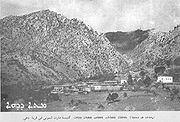
Dehi, Iraq
Encyclopedia

Assyrian people
The Assyrian people are a distinct ethnic group whose origins lie in ancient Mesopotamia...
Christian
Christian
A Christian is a person who adheres to Christianity, an Abrahamic, monotheistic religion based on the life and teachings of Jesus of Nazareth as recorded in the Canonical gospels and the letters of the New Testament...
village located at the western end of Mateena Mountains and in the valley that separates Sapna and Barwali Bala districts, in the Dohuk Governorate of Iraq
Iraq
Iraq ; officially the Republic of Iraq is a country in Western Asia spanning most of the northwestern end of the Zagros mountain range, the eastern part of the Syrian Desert and the northern part of the Arabian Desert....
. Most residents of village Dehi were the followers of the Assyrian Church of the East
Assyrian Church of the East
The Assyrian Church of the East, officially the Holy Apostolic Catholic Assyrian Church of the East ʻIttā Qaddishtā w-Shlikhāitā Qattoliqi d-Madnĕkhā d-Āturāyē), is a Syriac Church historically centered in Mesopotamia. It is one of the churches that claim continuity with the historical...
and others of Chaldean Catholic Church
Chaldean Catholic Church
The Chaldean Catholic Church , is an Eastern Syriac particular church of the Catholic Church, maintaining full communion with the Bishop of Rome and the rest of the Catholic Church...
.
There are ruins of a very old church on the top of the mountain overlooking the village and is believed to be built some 1400 years ago. Big stones are the only remnants of this church, which is called Mar Qayoma. Residents of Dehi believe that their village was built at the same time this ancient church was founded. The nature of the village is mountainous; therefore the areas of fertile soil were less available for farming. But nevertheless there are plenty of fruit trees.
There are currently 16 families living in the village.
The Armenians of Dehi

Oppression
Oppression is the exercise of authority or power in a burdensome, cruel, or unjust manner. It can also be defined as an act or instance of oppressing, the state of being oppressed, and the feeling of being heavily burdened, mentally or physically, by troubles, adverse conditions, and...
and genocide
Genocide
Genocide is defined as "the deliberate and systematic destruction, in whole or in part, of an ethnic, racial, religious, or national group", though what constitutes enough of a "part" to qualify as genocide has been subject to much debate by legal scholars...
perpetrated against Armenians
Armenians
Armenian people or Armenians are a nation and ethnic group native to the Armenian Highland.The largest concentration is in Armenia having a nearly-homogeneous population with 97.9% or 3,145,354 being ethnic Armenian....
during the First World War, many Armenian convoys fled to Iraq
Iraq
Iraq ; officially the Republic of Iraq is a country in Western Asia spanning most of the northwestern end of the Zagros mountain range, the eastern part of the Syrian Desert and the northern part of the Arabian Desert....
and Syria
Syria
Syria , officially the Syrian Arab Republic , is a country in Western Asia, bordering Lebanon and the Mediterranean Sea to the West, Turkey to the north, Iraq to the east, Jordan to the south, and Israel to the southwest....
seeking security.
The Armenian refugees who fled to Iraq in this phase came from two Armenia
Armenia
Armenia , officially the Republic of Armenia , is a landlocked mountainous country in the Caucasus region of Eurasia...
n regions:
First part: Refugees from the Armenia
Armenia
Armenia , officially the Republic of Armenia , is a landlocked mountainous country in the Caucasus region of Eurasia...
n village of Dehi, which is located in the middle between Sharnakh and Saart. Dehi had 700 Armenian
Armenians
Armenian people or Armenians are a nation and ethnic group native to the Armenian Highland.The largest concentration is in Armenia having a nearly-homogeneous population with 97.9% or 3,145,354 being ethnic Armenian....
families before the genocide. They were massacred by the Ottoman and Kurdish troops during World War I
World War I
World War I , which was predominantly called the World War or the Great War from its occurrence until 1939, and the First World War or World War I thereafter, was a major war centred in Europe that began on 28 July 1914 and lasted until 11 November 1918...
.
Only 40 families escaped and fled to Iraq to settle down in Zakho
Zakho
Zakho is a district and a town in Northern Iraq located a few kilometers from the Iraqi-Turkish border.Zakho is a province of the Dohuk Governorate. The city has 200,000 inhabitants. It may have originally begun on a small island in the Little Khabur which currently flows through the city...
.
By the 1970s, the village was built again and there were about 180 Armenian families in the village of Dehi.
Today there are no Armenians
Armenians
Armenian people or Armenians are a nation and ethnic group native to the Armenian Highland.The largest concentration is in Armenia having a nearly-homogeneous population with 97.9% or 3,145,354 being ethnic Armenian....
in Dehi.
Many of them moved from Zakho to other Iraqi cities.
Most of them migrated to Europe
Europe
Europe is, by convention, one of the world's seven continents. Comprising the westernmost peninsula of Eurasia, Europe is generally 'divided' from Asia to its east by the watershed divides of the Ural and Caucasus Mountains, the Ural River, the Caspian and Black Seas, and the waterways connecting...
in the last decades. Most of them are now in Holland in the region of Elmelo. The entire population is now Assyrian
Assyrian people
The Assyrian people are a distinct ethnic group whose origins lie in ancient Mesopotamia...
.

